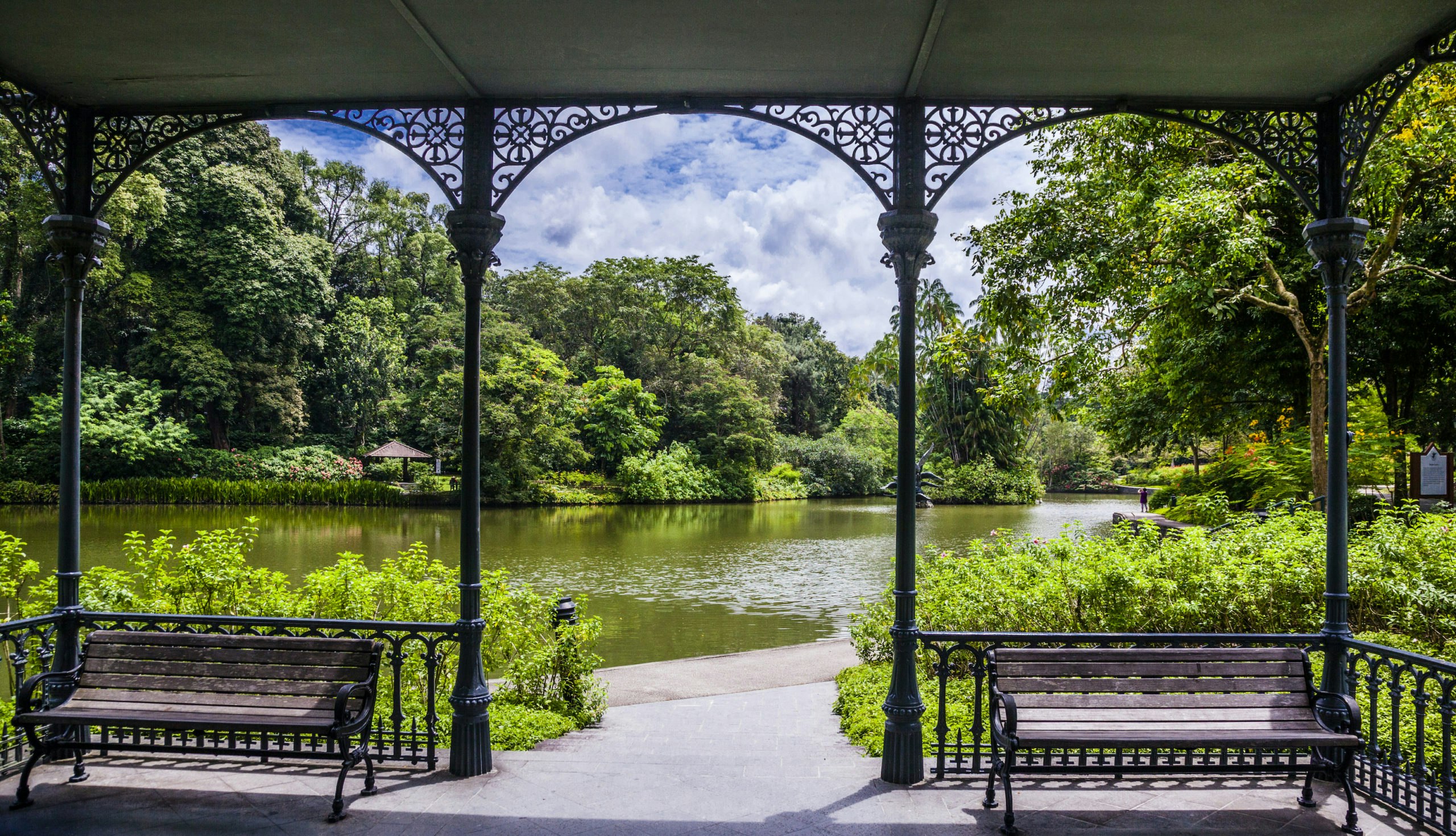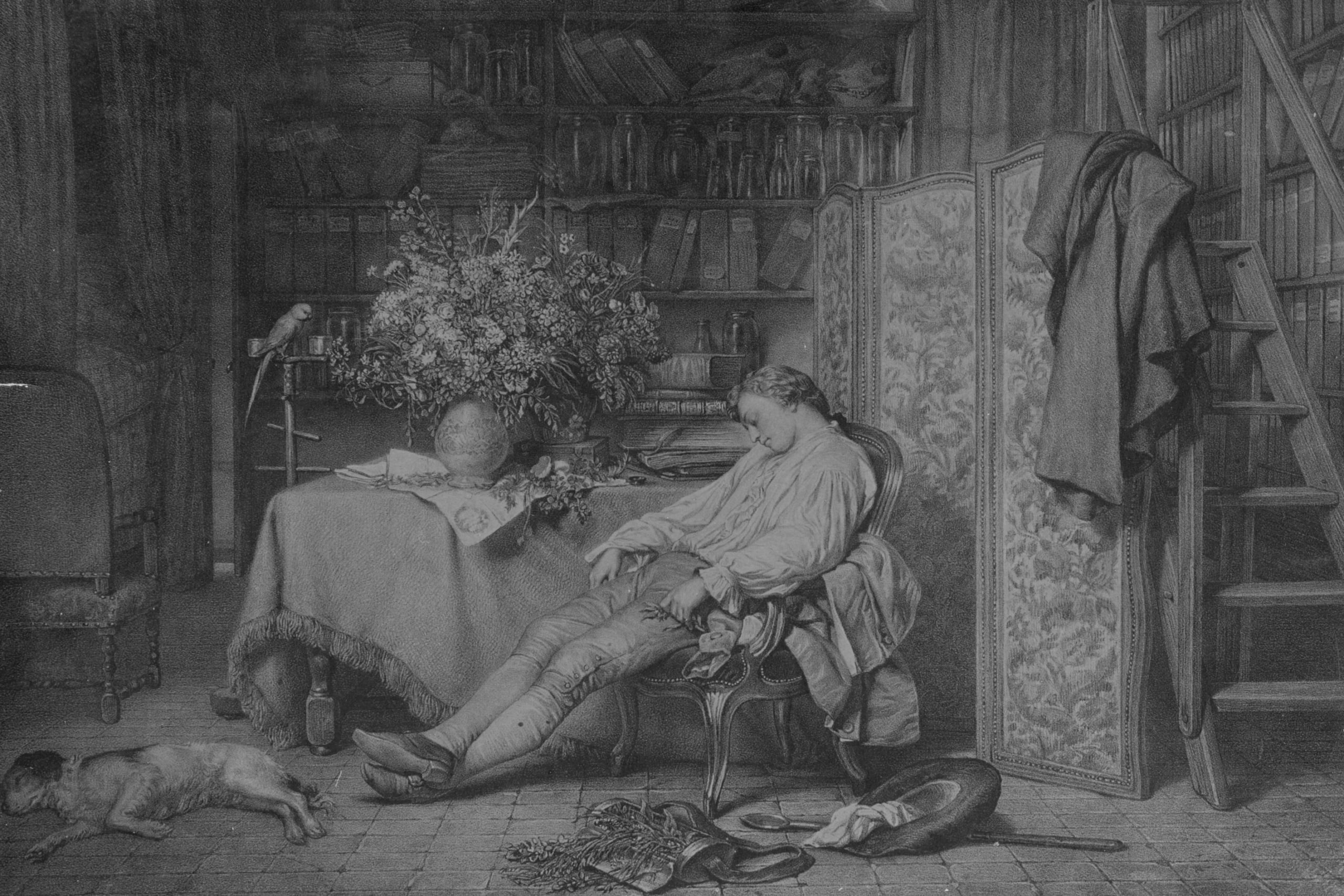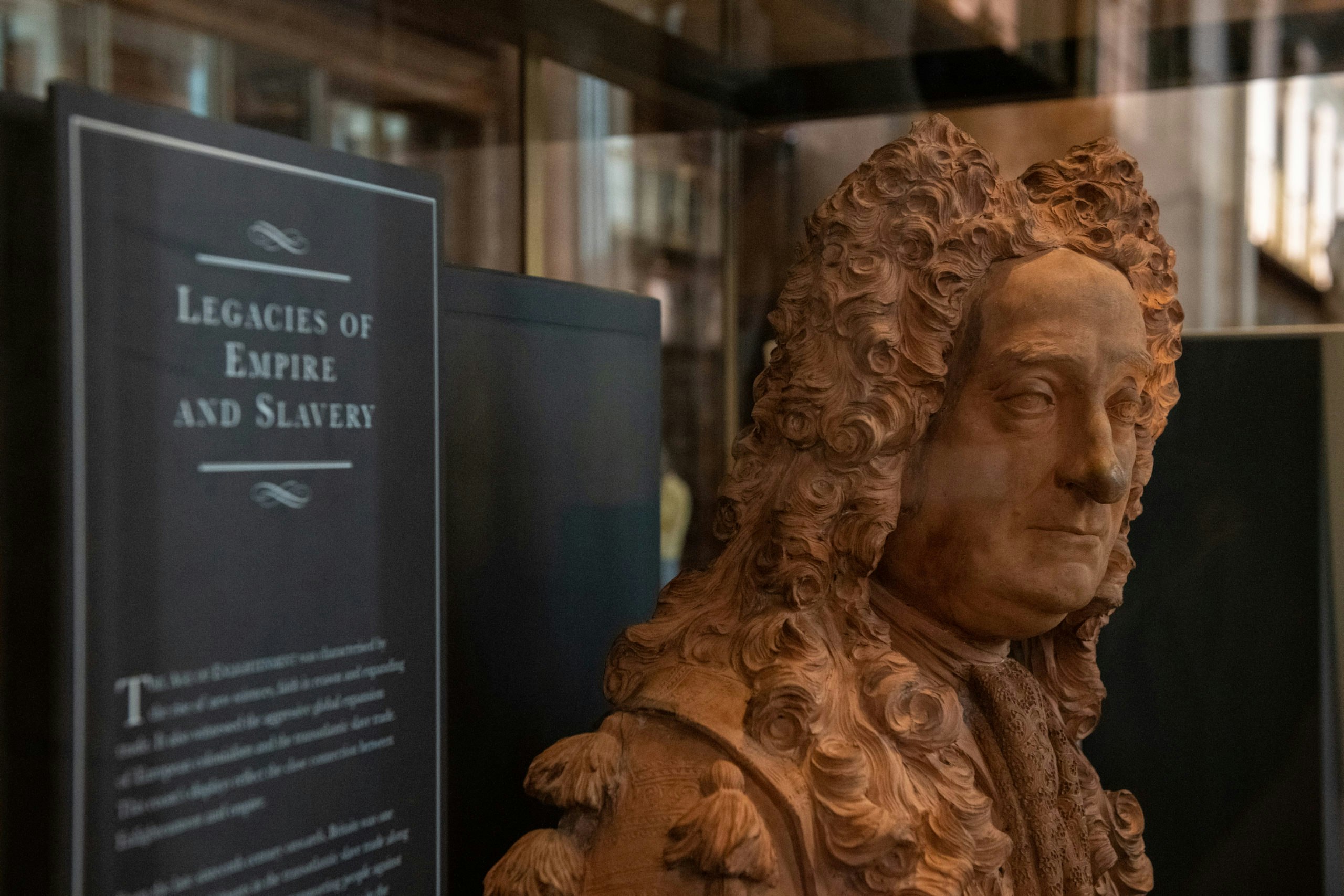The Long Shadow Of Colonial Science
Museums and gardens must become spaces that help us learn not only about biological life and human history, but also the colonialist and capitalist logic that still governs our everyday lives.
With the humidity set to around 80%, the lush and dense interior of the Palm House at London’s Kew Gardens offers a particular kind of solace from the English winter outside. The air is warm, heavy and infused with a muddle of earthy rainforest smells. Nestled within the larger expanse of an impeccably tended garden landscape, Palm House is, to many visitors, an escape within an escape: from the placid English garden to the controlled wilderness of what David Attenborough has called “a unique global rainforest.”
A large rubber tree, Hevea brasiliensis, which is native to parts of the Amazon basin and the Guianas, is a favorite with visitors here. Partly that’s because of the obvious connection between a plant and objects of daily use, and partly it’s because tourists from South America, Africa and Asia have particular relationships with this tree.
Rubber trees came to Kew illegally. In the summer of 1876, after more than a year in Brazil, the British explorer Henry Wickham returned to England with 70,000 rubber tree seeds. In Brazil, Wickham had declared to the authorities that the seeds were curiosities that he was taking back for the queen. He was lying; in London, he delivered the seeds to Joseph Hooker, the director of the botanical garden at Kew, for the princely sum of £700 (more than £16,000 or $23,000 today).
Biopiracy was no small matter in the 19th century. A decade before Wickham smuggled his rubber seeds back from Brazil, the government of Bolivia tortured and killed Manuel Incra Mamani, an Aymará Indian, for a similar crime. Mamani was accused of helping a British alpaca farmer, Charles Ledger, find a more potent variety of the Cinchona plant (the source of quinine, which cures malaria) and helping him smuggle its seeds back to Britain. But Wickham’s story, on the other hand, was celebrated as one that changed the modern world.
In Kew’s hothouses, less than 4% of Wickham’s rubber seeds germinated. But that was enough to transform vast tracts of land in British colonies in South and Southeast Asia into large-scale rubber plantations. British Malaya (now Singapore and the Malaysian peninsula) became the largest producer of rubber in the early 20th century thanks to the efforts of Henry “Rubber” Ridley, the first scientific director of the Botanical Gardens in Singapore, who worked hard to introduce new plants in the colonies that would generate profits back home.
Large rubber plantations required cheap land and cheap labor. For land, the colonial state sought out virgin forest that was portrayed for people back home as wild and unproductive. For labor, Britain relied on its colonial network: Coolies were shipped in from the Indian colonies, particularly the Madras Presidency in South India.
Clearing the land resulted in a series of short and long-term ecological disruptions that displaced complex multispecies soil ecologies and human settlement patterns. There is a perverse irony in the fact that plantation workers in Malaya were subject to some of the worst rates of malaria, because clearing the forest topsoil created a particularly fertile breeding ground for malaria-spreading anopheline mosquitos.
European colonies became the frontiers of exploration, extraction and production of tropical plants. They also became captive markets for exports, where colonial states were able to establish monopolies and manipulate import-export taxes. The botanical sciences aided the colonial enterprise and were, in turn, organized by it.
Global networks of botanical gardens emerged across the colonial world. These gardens were not simply landscaped spaces of pleasant greenery but experimental laboratories and way stations for colonial bioprospecting routes. Bioprospecting — the systematic search for useful products derived from bioresources like plants, microorganisms and animals — in recent years has been the domain of big multinational agro-industries and pharmaceutical companies. Its roots lie in the early colonial period, however, and it follows a similar extractive logic.

When a small quantity of rubber first arrived in Europe as a curiosity in the 1730s, it was called “caoutchouc.” The name means weeping wood and was derived from Quechuan, a language family of the Peruvian Andes. It was the British scientist Joseph Priestly who noticed that the malleable latex that oozed from damaged bark on the tree rubbed pencil marks off paper, so he introduced the name “rubber.”
The European approach to rubber, as with other plant extracts, was always use-oriented. The heroic history of science characterizes early botany as a “pure” scientific pursuit, invested particularly in the naming and classifying of plants and the order of nature. What is often left unsaid is that early 18th-century botany as an academic discipline existed only because knowledge about the properties of plants for medicinal and economic purposes was important to European states.
In time, the classification of plants became a natural stepping-stone to a more sinister classification of humans. In 1758, the Swedish botanist and taxonomist Carl Linnaeus — whose name lives on at the Linnean Society of London, which prides itself as “the world’s oldest active society devoted to natural history” — classified humans into four groups that corresponded to the Americas, Europe, Asia and Africa and were organized on the basis of color: red, white, yellow and black. The color of skin was then made to correspond to the “humors” — the four main fluids of the body that were thought in medieval science to determine a person’s physical and mental qualities.
This human taxonomy would have long-ranging impacts on the emergence of the social category we now know as race. Caucasians were characterized as white, sanguine and muscular and Africans as black, phlegmatic and lazy. Skin color, of course, evolved independently of other traits like mental abilities and behavior, and there is no evidence to suggest that there are genetic differences between populations.
Race science served the logic of colonialism in many ways. The assumed superiority of Europeans legitimized the impulse to dominate. It also allowed for the dismissal of indigenous systems of cultivation and food systems as not agriculture. In other words, it justified taking over land under the assumption that indigenous communities were racially incapable of being stewards of it. This colonialist (racist) logic was the same that was used to justify slavery in the United States.


As natural history grew into a robust and profitable discipline in Europe, its ties to the slave trade deepened. British naturalists such as James Petiver and Dru Drury employed surgeons, most of whom were trained in botany, on slave ships as proxy collectors. Petiver’s collection was bought up by Sir Hans Sloane after Petiver’s death. Sloane was among the most powerful men of science of the time, and he is beloved for introducing drinking chocolate to Britain. Early in his career, he worked as a medical doctor on plantations in the Caribbean and used the labor and knowledge of enslaved West Africans — Akan men and women mainly from present-day Ghana and Cote d’Ivoire — to bring back more than 800 plant specimens and other “curiosities.” These curiosities included skin and skull specimens as well as nooses and whips used to punish fugitives. When Sloane returned to London, he deployed a wide network of Europeans in the slave trade to build on his nascent collection, which now forms a large part of the Natural History Museum collection in London.
Slave ships reached places others did not. Training enslaved people as collectors became a practice in some parts. “Brutes are botanists by instinct,” the British planter in Jamaica Edward Long wrote in 1774. Long went on to describe how Costa Rican monkeys applied moss and chewed leaf poultices to gunshot wounds. Europeans were explicitly derogatory toward the abilities of indigenous peoples, but their knowledge helped shape much of the foundational directions of European natural history.
Race science in the 19th century went beyond classifying people into tiers of appearance and ability to the “measurement” of human progress. The origins of human civilization and human progress were becoming primary preoccupations at the time. Ethnology, a new field, investigated the question of whether humans had a single origin (monogenesis) or multiple origins (polygenesis) across the world.
In 1871, Charles Darwin (a biologist) published “The Descent of Man,” which concluded that the human species had one common ancestor and that humans evolved slowly, like all other forms of life. This should have fundamentally settled the race debate, but it did not. What it did instead was open the field to studying the gradations of evolution within the human species. Human progress was seen as something gradual, a continuing increase in rationality, with (European) scientific thought replacing the world of myth and belief systems. Into this, social and cultural evolutionism emerged as a new anthropological direction.
Comparing different groups’ levels of civilizational development became the cornerstone of various ethnographic museums in Europe, among which the Pitt Rivers Museum at the University of Oxford stands out. The museum was founded in 1884 from the collection of the elaborately named and wealthy archaeologist General Augustus Henry Lane-Fox Pitt-Rivers, who had started collecting objects to feed his interest in modern musketry and expanded from there to anthropological and ethnographic areas.


Pitt-Rivers claimed to have coined the term “typology” in his 1891 essay “Typological Museums.” Considering material culture the “outward signs or symbol of particular ideas in the mind,” typological displays placed artifacts of the same type from different cultures together and arranged them from left to right to create a superficial visual sequence in order of “primitiveness” to “sophisticated” and “specialized” forms. Other ethnographic museums across Europe took up such displays to position cultures in relation to others, with Europe always at the apex of development.
For Pitt-Rivers, the concept of evolution as scientific truth justified his politics. The theory of cultural evolution justified the existing social order and the expansion of the British Empire. It also encouraged a dangerous form of racism.
In an earlier essay, “Primitive Warfare,” Pitt-Rivers claimed that civilization has always been “confined to particular races, whose function it has been by means of war and conquest, to spread the arts amongst surrounding nations, or to exterminate those whose low state of mental culture rendered them incapable of receiving it.” These were not unusual comments, nor were they merely academic. Many anthropologists at the time were comfortable with the genocide of Aboriginal Tasmanians in the 1820s and 30s. They were convinced that Tasmanian society remained a paleolithic one and thus its extermination was, in fact, necessary.
Pitt-Rivers relinquished decision-making powers over his collection when he donated it to Oxford. Henry Balfour, who was hired as assistant curator, followed Pitt-Rivers’ evolutionary approach. Balfour was trained as an animal morphologist. He took design traits to be analogous with cultural groups and sought to fit both into a hierarchy of developmental stages. His role as curator was to fill in the typologies and to create new ones as artifacts became available.
To this day, the Pitt Rivers Museum retains its typological displays. The museum is often described by visitors as weird and wonderful, a place stopped in time. Recently, student activists from the Rhodes Must Fall movement called it a violent space. To enter, visitors walk through the more spacious hall of the adjacent Natural History Museum, past a parade of skeletons. The lineup of calcified bone is meant to reveal some of the diversity of evolutionary adaptations in large mammals. This evolutionary approach extends into the Pitt Rivers Museum, with weapons, basketry and smoking pipes from different cultures, each type of object crammed into its own vitrines. A violent history of science and collecting, with many stories untold, hangs uneasily over the space.

Minik Wallace arrived in New York City from Greenland with the American explorer Robert Peary in 1897. Peary was bringing Minik, along with his father Qisuk and others from their homeland, as living specimens of Inuit culture. Qisuk contracted tuberculosis and died shortly after they arrived. The museum curators staged a fake burial, then de-fleshed his body and mounted his bones on an armature to put on display. “You’re a race of scientific criminals,” Minik told them. “I know I’ll never get my father’s bones out of the museum. … I’m glad enough to get away before they grab my brains and stuff them into a jar.”
Minik returned to Greenland around 1910, but a few years later went back to the U.S. He died of influenza in the 1918 pandemic. In 1993, in response to public pressure, the museum agreed to return the Inuit remains it had held until then.
Does returning human remains or sacred objects mean erasing the history that led to its acquisition in the first place? It shouldn’t. Museums need to recognize these histories are an intrinsic part of the stories they must be telling. The misguided and violent practices of scientific inquiry are highly relevant for museum-goers — and now more than ever, when, for example, members of the alt-right promote ancestry-testing as a way to prove their whiteness.
In the last few years, the curators at the Pitt Rivers Museum have instigated various small initiatives to “address its legacy of colonialism.” The “restitution of knowledge” project led by Dan Hicks, Monica Hanna, Ciraj Rassool and Bénédicte Savoy is one of the more substantial undertakings. It “aims to build and share knowledge of incidents of looting during military expeditions, and to document connections between these events and objects in European museums to inform and support restitution.” Similarly, the Natural History Museum in London has initiated projects to study its colonial legacies and its relationship to slavery; curators such as Miranda Lowe and Subhadra Das have written about how the collections preserve colonial ideologies and narratives, and how they can be used to recontextualize natural history collections.
Museums and botanical gardens are starting to invite contemporary artists working with archives and research-based practices to stage interventions in the museum space. These often serve as powerful ways to highlight the histories of colonial collections and the voices that remain absent. The Mexican-born artist Mariana Castillo Deball’s exhibition at Modern Art Oxford, for example, works to rediscover individuals who have been written out of history in traditional museum displays and archives. One such figure is Makereti, who was born to a Maori mother and an English army officer. She became an interpreter for Maori culture and often escorted visitors through the Whakarewarewa geyser valley on New Zealand’s North Island. In 1924, Makereti enrolled as a student of anthropology at the University of Oxford and donated her personal collection of Maori possessions to the Pitt Rivers Museum. Stories such as Makereti’s serve to muddy the waters of ethnographic study and collecting, where the line between the observer and the observed is crossed, as it so often is in the study of people and cultures.
At Edinburgh Printmakers, which was previously home to the North British Rubber Company, the 2019 exhibition “Transparency” is another example of artists looking forward and backward in time, connecting what is often thought to be disparate bits of botanical, industrial and military history. A film by the Barbadian-Scottish artist Alberta Whittle, “What Sound Does The Black Atlantic Make?,” was part of the exhibition. Through the rubber Wellington boots produced in Scotland and used in trench warfare in the First World War, Whittle links rubber manufacturing in Scotland to colonial plantations and African regiments involved in the war effort.
Products of European oppression as they may be, museums are uniquely placed to honestly reflect the colonialist and capitalist processes that continue to shape our everyday lives. Multispecies storytelling in botanical gardens makes visible the lives of plants, animals and microorganisms beyond the taxonomic frames into which they have been organized, and they help us discover the diversity of connected life. These connections extend far beyond biological life, of course, and it is museums and gardens that can enlarge our awareness of the complex colonial histories of scientific collections. We are poised at a moment at which there is a tremendous surge of energy among young scholars and curators towards making such changes and telling such stories.
https://www.noemamag.com/the-long-shadow-of-colonial-science/?utm_source=noemafacebook&utm_medium=noemasocial&fbclid=IwAR0esf7qE4anBYX1u8avAUwp1H0wF83NeQRo8ZPJ0DB7mIO7IRUpaS0Ske4
posted by Satish Sharma at
05:22
![]()

0 Comments:
Post a Comment
Subscribe to Post Comments [Atom]
<< Home